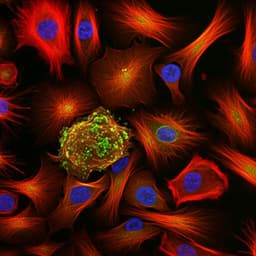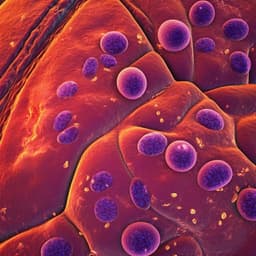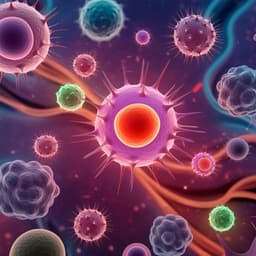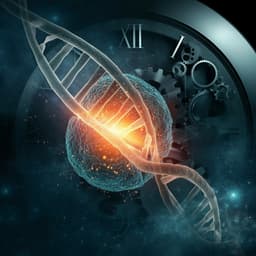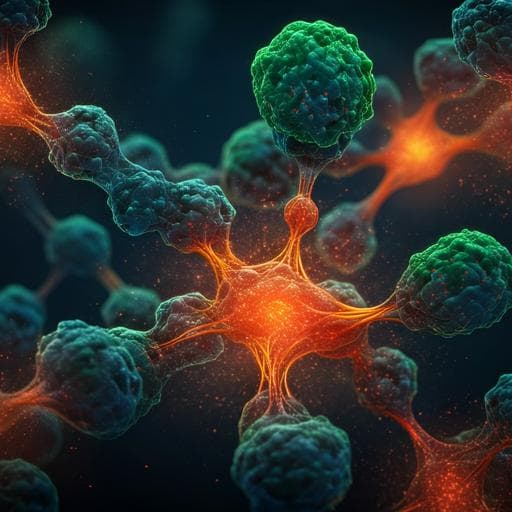
Medicine and Health
Single-cell sequencing of ascites fluid illustrates heterogeneity and therapy-induced evolution during gastric cancer peritoneal metastasis
X. Huang, M. Pang, et al.
This fascinating study delves into the complexities of peritoneal metastasis in gastric cancer, unveiling how certain immune cells evolve under therapy and their impact on prognosis. Conducted by a dedicated team of researchers, these insights shed light on the trajectories of cancer and immune cells during metastasis progression, promising innovative pathways for therapy-resistant cases.
~3 min • Beginner • English
Introduction
Gastric cancer is among the most common malignancies and peritoneal metastasis is a major cause of mortality. The mechanisms driving gastric cancer peritoneal metastasis (GCPM) and the therapy-induced changes within ascites remain poorly defined. The peritoneal ecosystem comprises diverse immune and non-immune cell populations, and both exfoliated tumor cells and immune cells undergo dynamic changes during GCPM and in response to therapy. Single-cell characterization of this ecosystem could elucidate how immune dysfunction, tumor cell plasticity, and cell-cell interactions contribute to metastasis and therapy resistance. This study aims to profile, at single-cell resolution, the cellular composition and states of ascites/peritoneal lavage across disease stages and treatments, to reveal key immune and tumor programs (including paligenosis) underpinning GCPM progression and therapeutic evolution.
Literature Review
Prior work has mapped intratumoral heterogeneity and lineage diversity in primary gastric cancer and peritoneal metastases, but early peritoneal ecosystem dynamics and therapy-induced immune checkpoint evolution remained unclear. Paligenosis, a conserved program by which differentiated epithelial cells re-enter the cell cycle via autophagy induction followed by mTORC1 activation, has been implicated in metaplasia and possibly in gastric tumorigenesis. Existing studies have profiled myeloid heterogeneity and therapy-induced evolution in other cancers and highlighted immunometabolic reprogramming and immunosuppression in tumor microenvironments. These findings motivated comprehensive single-cell analyses of ascites to uncover analogous programs in GCPM.
Methodology
- Cohort and sampling: 35 patients across four medical centers, grouped as G0 (n=4 benign hysteromyoma peritoneal lavage, controls), G1 (n=4 early gastric cancer lavage), G2 (n=10 advanced GC lavage), G3 (n=12 untreated advanced GC with GCPM ascites), G4 (n=5 advanced GC with GCPM ascites after systemic therapy: 3 chemotherapy, 2 anti-PD-1/PD-L1 immunotherapy). Additional ascites samples were used to establish patient-derived organoids (PDOs).
- Single-cell RNA-seq: 10x Genomics Chromium Single Cell 3' v3.1; sequencing on Illumina NovaSeq 6000 (PE150). Quality control filters (<200 genes, <800 UMIs or top 1% UMIs, >20% mitochondrial genes; DoubletFinder to remove doublets). Integration and batch correction via Harmony; clustering and visualization via Seurat (PCA/UMAP). 191,987 high-quality cells obtained (average 2,744 genes, 11,177 UMIs, ~6% mitochondrial reads per cell).
- Cell type identification: Marker-based annotation (SingleR plus manual curation) into immune (T, NK, DCs, macrophages/monocytes, B, plasma, mast, neutrophils) and non-immune (tumor epithelial cells, fibroblasts, mesothelial) populations; inferCNV to confirm malignancy of epithelial cells.
- Myeloid/T cell re-clustering: Myeloid subdivided into DC (cDC1, cDC2 and monocyte-like DCs), macrophage (including MDSC- and TAM-like), monocyte, neutrophil, mast clusters. T/NK subdivided into CD4 subsets (naïve, effector memory, Treg), CD8 subsets (effector/EM, MAIT, tissue-resident), cycling T, and NKT cells.
- Functional scoring and pathway analysis: Gene signature-based function scores (antigen-presenting, pro-angiogenic, cytotoxic, naïve, inhibitory, proliferative, Treg, etc.). Metabolism activities via GSVA; pathway enrichment via GSEA (MSigDB); TF activity via SCENIC.
- Trajectory inference: Monocle 2 (DDRTree) to define pseudotime trajectories for DCs, cycling T cells, and tumor cells; dynamic gene expression and checkpoint analyses along pseudotime.
- Chemokine quantification: ELISA of ascites/peritoneal lavage for CXCL16, CCL2, CCL3, CCL4, CCL5 and others; comparison with scRNA-seq expression.
- Flow cytometry (FACS): Identification and sorting of cDC2 and monocyte-like DCs from ascites/lavage; qPCR validation of chemokine expression in sorted cells.
- Organoid experiments: Ascites-derived PDO culture (4 patients); immunofluorescence for paligenosis markers (DDIT4, ATF3, pS6, Ki67), MARCKS, TXNIP, SOX9. Drug treatments with autophagy inhibitors (DC661, hydroxychloroquine) and mTORC1 inhibitors (TORIN1, rapamycin); assessment of organoid growth (size), viability/apoptosis (CC3/Ki67), and in vivo PDO xenograft mouse model with PET imaging.
- Statistics: Student’s t-test, Wilcoxon test, one-way ANOVA with Tukey post hoc where applicable, log-rank for survival analyses (GEPIA2). Significance threshold p<0.05.
Key Findings
- Dataset: 191,987 single cells profiled from ascites/peritoneal lavage across G0–G4 groups.
- Global ecosystem shifts: Twelve major cell types identified. During GCPM progression, T cell proportion increased and macrophage/monocyte proportion trended down. CXCL16 chemokine increased with GCPM (ELISA p=5.9e-5), consistent with T cell recruitment.
- Dendritic cells: cDC2 decreased in GCPM (p=0.0128). Within cDC2, monocyte-like DCs (C2-DC, C3-DC) increased in G3 vs G1 (p=0.0038) and G3 vs G2 (p=0.0021). FACS confirmed decreased cDC2 in ascites (p=0.0355) and higher monocyte-like DC fraction within cDC2 in ascites (p=0.0195). Monocyte-like DCs showed reduced antigen-presenting capacity and increased pro-angiogenic features; C3-DC was proliferative (MCM4/6, PCNA) with pro-angiogenic markers (SPP1, STAB1, TYMP). DC trajectory placed cDC1/cDC2 at origin and monocyte-like/proliferative C3-DC at terminal pseudotime, with progressive upregulation of glycolysis and fatty acid metabolism and immune checkpoints (HAVCR2, CD47, LGALS9, CD276). C3-DC signature associated with worse TCGA STAD prognosis (p=0.0066).
- Macrophages: Identified MDSC-like (C2-Macro; FCN1, S100A8) and TAM-like (C3-Macro; APOE, TREM2) phenotypes; C3-Macro signature trended toward poor prognosis (median 24 vs 60 months; p=0.098).
- T/NK cells: Increased proportions of naïve CD4 (C2-CD4) and Treg (C3-CD4) in G3 (C2-CD4 G3 vs G1 p=1.4e-4; G3 vs G2 p=4.2e-4. C3-CD4 G3 vs G1 p=6.5e-3; G3 vs G2 p=0.0103). MAIT (C3-CD8) decreased in G3 vs G1 (p=0.0217) and G2 (p=0.0494) with reduced cytotoxicity. A proliferative cycling T cluster exhibited high proliferation markers (MKI67, MCM2, PCNA), low cytotoxicity, high inhibitory markers, and naïve-like features; trajectory from naïve CD8 to cycling T2 showed increased glycolysis/fatty acid/NAD metabolism and acquisition of exhaustion/dysfunction.
- Therapy-induced evolution (G3 vs G4): C2-DC decreased post-therapy (p=0.0161). C3-DC gained proliferative and pro-angiogenic capacity and reduced antigen presentation; upregulated inflammatory chemokines CCL2/3/4 post-therapy and pathways (inflammatory response, NF-κB, chemokine, EMT, Notch), while G3 C3-DC enriched for antigen processing/MHC-II pathways. Metabolic reprogramming in DCs: C3-DC increased oxphos/glycolysis; C2-DC decreased mitochondrial functions.
- T cell changes post-therapy: Treg (C3-CD4) proportion decreased (p=0.0060); cycling T cells showed reduced cytotoxic/proliferative and increased naïve function, upregulated drug metabolism genes (MGST1, GSTP1, NME1, NME2), and metabolic shifts (upregulated oxphos, TCA, glutathione metabolism).
- Immunotherapy vs chemotherapy (small subset: 2 vs 3 patients): C2-DC and C3-DC proportions decreased with immunotherapy; both monocyte-like DCs and TAM-like macrophages shifted to anti-inflammatory phenotypes with reduced NF-κB/pro-inflammatory signatures. PD-L1/PD-L2 were rarely expressed in these myeloid cells; alternative checkpoints (VSIR, MIF, LGALS9, SIGLEC10) were expressed and increased under immunotherapy. CD4 naïve and Treg proportions decreased under immunotherapy; co-stimulatory markers increased. Immunotherapy modestly increased the fraction of high-cytotoxic CD8 T cells but did not markedly increase overall cytotoxic scores; several T cell checkpoints (CTLA4, TIGIT, CD47, CD96, TNFRSF1B; and VSIR, CD47, CD96, TNFRSF1B in cycling T) were upregulated.
- Tumor cell programs and paligenosis: Epithelial tumor cells formed 7 clusters; core shared clusters C1 (highly differentiated), C2 (high plasticity; autophagy-high, mTORC1-low, early paligenosis markers DDIT4, ATF3), and C3 (high proliferation; mTORC1-high, MKI67/MCM2, late paligenosis). Trajectory supported C2-to-C3 transition consistent with paligenosis stages. Post-therapy (G4), C2 increased plasticity (Hedgehog, ERBB, polarity remodeling), then transitioned to proliferative C3 with Wnt activation; both C2 and C3 showed metabolic reprogramming and multidrug resistance signatures; C2 decreased mitochondrial metabolism and increased glycolysis/glycogen metabolism.
- Biomarkers and interventions: MARCKS and TXNIP identified as autophagy-related markers enriched in high-plasticity C2 tumor cells and associated with poor prognosis; co-localized with early paligenosis markers in PDOs. Autophagy inhibitors (DC661, hydroxychloroquine) and mTORC1 inhibitors (TORIN1, rapamycin) reduced PDO growth; autophagy inhibitors were more effective and uniquely induced apoptosis (increased CC3/Ki67 ratio). In PDO xenograft mice, hydroxychloroquine and rapamycin both inhibited peritoneal metastasis by PET imaging, with hydroxychloroquine more effective.
Discussion
This study demonstrates that GCPM progression reshapes the peritoneal ecosystem toward immunosuppression and pro-angiogenesis through expansion and evolution of monocyte-like cDC2 subsets with diminished antigen presentation and increased angiogenic programs. Concurrently, T cell compartments become enriched for naïve and Treg phenotypes while cytotoxic function wanes, and a proliferative cycling T population exhibits an exhausted, dysfunctional state. Anti-tumor therapies further remodel these states: monocyte-like DCs gain proliferative and pro-angiogenic features and T cells shift toward naïve programs with upregulated drug metabolism and altered energetics, potentially as a stress-adaptive response. Immunotherapy, while reducing naïve/Treg proportions and increasing co-stimulation, appears to induce alternative inhibitory checkpoints in myeloid and T cells, suggesting compensatory immune evasion mechanisms outside the PD-1/PD-L1 axis.
On the tumor side, high-plasticity gastric cancer cells transition to high-proliferative states via a conserved paligenosis-like program involving early autophagy and later mTORC1 activation. Therapy accentuates plasticity and metabolic rewiring, consistent with treatment-induced selection of adaptable states. Identification of MARCKS and TXNIP as markers of high-plasticity tumor cells and the efficacy of autophagy inhibition in PDOs and in vivo implicate paligenosis components as actionable vulnerabilities. Intercellular communication analyses suggest that monocyte-like DCs and cycling T cells may reinforce tumor plasticity via ligand-receptor interactions (e.g., SPP1/HGF-CD44), linking immune remodeling to maintenance of tumor stemness and therapy resistance.
Conclusion
Single-cell profiling of ascites reveals that during GCPM, monocyte-like dendritic cells with pro-angiogenic, immunosuppressive phenotypes expand, T cells become increasingly naïve or regulatory with reduced cytotoxicity, and high-plasticity gastric cancer cells transition to proliferative states through a paligenosis-like program. Therapy induces further evolution in both immune and tumor compartments, including metabolic reprogramming and alternative immune checkpoint upregulation. MARCKS and TXNIP mark high-plasticity tumor cells, and targeting paligenosis via autophagy or mTORC1 inhibition suppresses PDO growth, with autophagy blockade inducing apoptosis and reducing peritoneal metastasis in vivo. These findings highlight paligenosis and non-PD-1/PD-L1 immune checkpoints as potential therapeutic targets and support ascites-based monitoring of tumor-immune dynamics. Future research should validate these mechanisms in larger treated cohorts, dissect specific ligand-receptor pathways maintaining tumor plasticity, and develop combinatorial strategies integrating autophagy/mTORC1 inhibitors with immunotherapy.
Limitations
Comparisons between chemotherapy and immunotherapy were based on a small number of post-treatment ascites samples (immunotherapy n=2, chemotherapy n=3), limiting generalizability. Single-cell transcriptomics provides correlative insights into state transitions and metabolic programs without direct lineage tracing in patients. While PDO and mouse models support mechanistic hypotheses around paligenosis and autophagy dependence, broader validation across diverse patient-derived models and prospective clinical studies is needed. The study focuses on gastric cancer-related ascites; comparisons with ascites from other etiologies were conceptual and not systematically analyzed here.
Related Publications
Explore these studies to deepen your understanding of the subject.



